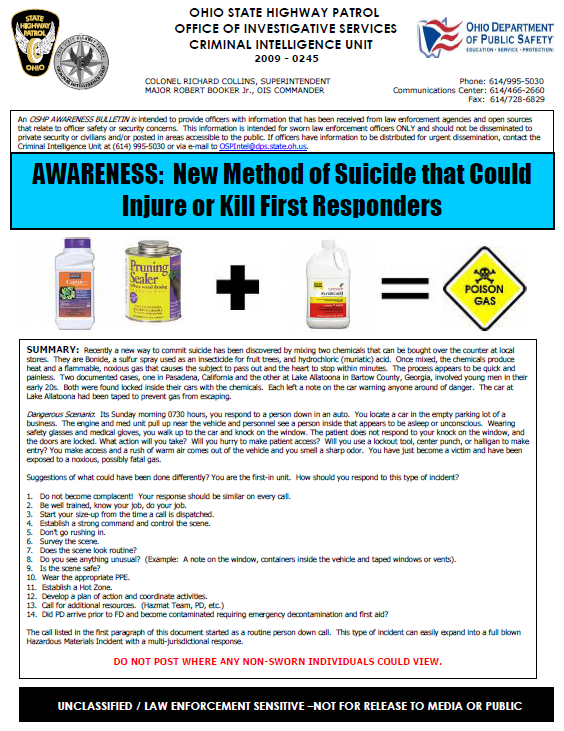OHIO STATE HIGHWAY PATROL
- Office of Investigation Services
- Criminal Intelligence Unit
- Law Enforcement Sensitive
- March 2, 2009
SUMMARY: Recently a new way to commit suicide has been discovered by mixing two chemicals that can be bought over the counter at local stores. They are Bonide, a sulfur spray used as an insecticide for fruit trees, and hydrochloric (muriatic) acid. Once mixed, the chemicals produce heat and a flammable, noxious gas that causes the subject to pass out and the heart to stop within minutes. The process appears to be quick and painless. Two documented cases, one in Pasadena, California and the other at Lake Allatoona in Bartow County, Georgia, involved young men in their early 20s. Both were found locked inside their cars with the chemicals. Each left a note on the car warning anyone around of danger. The car at Lake Allatoona had been taped to prevent gas from escaping.
Dangerous Scenario: Its Sunday morning 0730 hours, you respond to a person down in an auto. You locate a car in the empty parking lot of a business. The engine and med unit pull up near the vehicle and personnel see a person inside that appears to be asleep or unconscious. Wearing safety glasses and medical gloves, you walk up to the car and knock on the window. The patient does not respond to your knock on the window, and the doors are locked. What action will you take? Will you hurry to make patient access? Will you use a lockout tool, center punch, or halligan to make entry? You make access and a rush of warm air comes out of the vehicle and you smell a sharp odor. You have just become a victim and have been
exposed to a noxious, possibly fatal gas.Suggestions of what could have been done differently? You are the first-in unit. How should you respond to this type of incident?
1. Do not become complacent! Your response should be similar on every call.
2. Be well trained, know your job, do your job.
3. Start your size-up from the time a call is dispatched.
4. Establish a strong command and control the scene.
5. Don’t go rushing in.
6. Survey the scene.
7. Does the scene look routine?
8. Do you see anything unusual? (Example: A note on the window, containers inside the vehicle and taped windows or vents).
9. Is the scene safe?
10. Wear the appropriate PPE.
11. Establish a Hot Zone.
12. Develop a plan of action and coordinate activities.
13. Call for additional resources. (Hazmat Team, PD, etc.)
14. Did PD arrive prior to FD and become contaminated requiring emergency decontamination and first aid?The call listed in the first paragraph of this document started as a routine person down call. This type of incident can easily expand into a full blown Hazardous Materials Incident with a multi-jurisdictional response.

